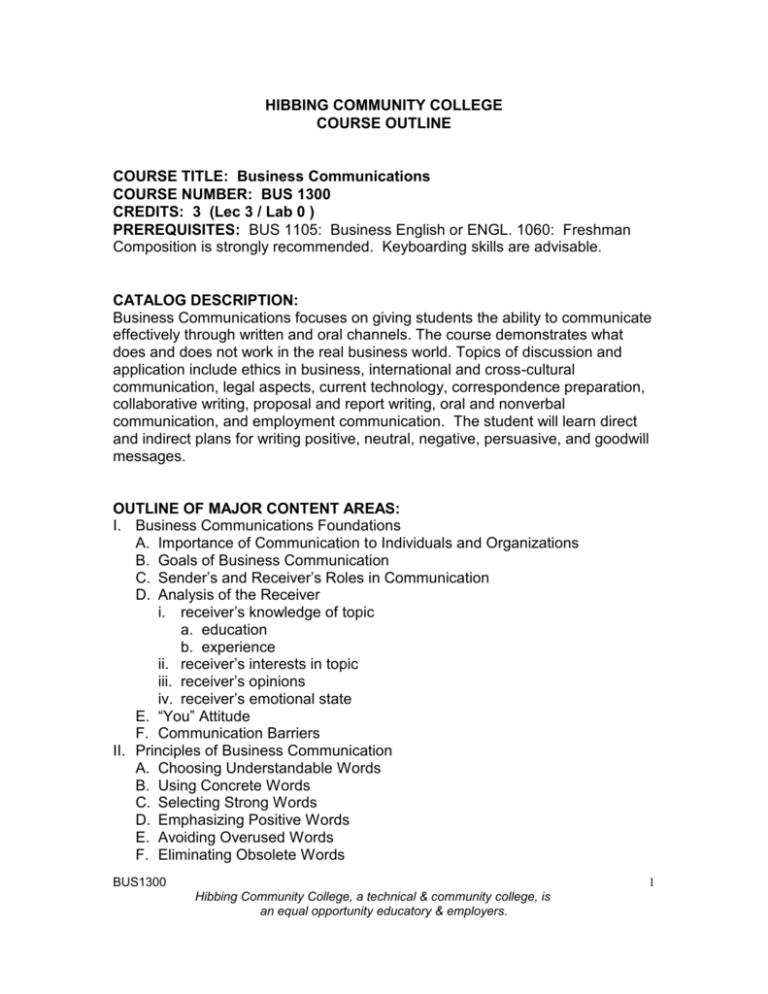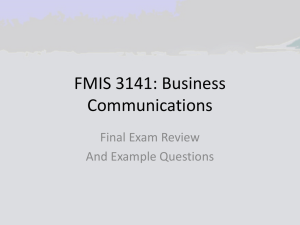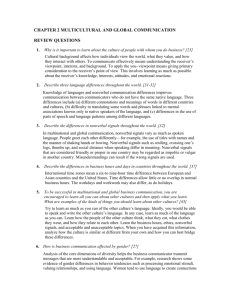BUS 1300 - Hibbing Community College
advertisement

HIBBING COMMUNITY COLLEGE COURSE OUTLINE COURSE TITLE: Business Communications COURSE NUMBER: BUS 1300 CREDITS: 3 (Lec 3 / Lab 0 ) PREREQUISITES: BUS 1105: Business English or ENGL. 1060: Freshman Composition is strongly recommended. Keyboarding skills are advisable. CATALOG DESCRIPTION: Business Communications focuses on giving students the ability to communicate effectively through written and oral channels. The course demonstrates what does and does not work in the real business world. Topics of discussion and application include ethics in business, international and cross-cultural communication, legal aspects, current technology, correspondence preparation, collaborative writing, proposal and report writing, oral and nonverbal communication, and employment communication. The student will learn direct and indirect plans for writing positive, neutral, negative, persuasive, and goodwill messages. OUTLINE OF MAJOR CONTENT AREAS: I. Business Communications Foundations A. Importance of Communication to Individuals and Organizations B. Goals of Business Communication C. Sender’s and Receiver’s Roles in Communication D. Analysis of the Receiver i. receiver’s knowledge of topic a. education b. experience ii. receiver’s interests in topic iii. receiver’s opinions iv. receiver’s emotional state E. “You” Attitude F. Communication Barriers II. Principles of Business Communication A. Choosing Understandable Words B. Using Concrete Words C. Selecting Strong Words D. Emphasizing Positive Words E. Avoiding Overused Words F. Eliminating Obsolete Words BUS1300 1 Hibbing Community College, a technical & community college, is an equal opportunity educatory & employers. G. Composing Clear Sentences H. Varying Length of Sentences I. Using Active Voice in Sentences J. Giving Sentences Appropriate Emphasis K. Using Appropriate Length Paragraphs L. Giving Paragraphs Unity M. Organizing Paragraphs Logically III. Developing Business Messages A. Determining Purpose of Message B. Analyzing Receiver C. Composing Message Content i. oral or written ii. direct or indirect plan iii. outline message content iv. draft the message v. edit and revise the message vi. proofread the message D. Determining Vocabulary Level E. Ethics n Business F. Legal Requirements in Business IV. Communication Technologies and Techniques V. International and Cross-cultural Business Communication A. Language Differences B. Nonverbal Communication Differences C. Cultural Differences VI. Positive and Neutral Messages A. Direct Plan i. inquiries ii. claims iii. requests iv. adjustments B. Indirect Plan VII. Negative Messages A. Indirect Plan B. Direct Plan VIII.Persuasive Messages A. Indirect Plan i. requests ii. recommendations iii. special claims iv. sales messages v. collection messages IX. Goodwill Messages X. Business Studies and Proposals BUS1300 2 Hibbing Community College, a technical & community college, is an equal opportunity educatory & employers. XI. Written Reports A. Formal and Informal Reports B. Special Reports XII.Listening and Nonverbal Messages XIII.Oral Communications in Business XIV.Employment Communications and Interviewing A. Employment Opportunities B. Personal Resume Preparation C. Application Letters D. Interviewing Techniques E. Follow-up Letters COURSE GOALS/OBJECTIVES/OUTCOMES: Students will 1. define business communication and describe its importance, goals, and patterns. 2. explain the communication process. 3. recognize the communication barriers and describe how to remove them. 4. choose words that the receiver will understand and that will gain the receiver reaction needed for successful communication. 5. develop clear, concise, and effective sentences. 6. form clear, concise, logical, coherent, and effective paragraphs. 7. apply personal composing style to give uniqueness and life to messages. 8. apply a three-step process for planning and composing effective business letters. 9. describe how the vocabulary level of business messages can be determined. 10. write in groups. 11. choose ethical content for business messages. 12. explain how to assure the legality of business messages. 13. select available alternatives to assure unbiased language in business messages. 14. explain how technology can be used to improve business communication. 15. identify message situations as routine and/or repetitive and recommend preparation and distribution methods. 16. describe the challenges of international and cross-cultural business communication. 17. apply the guidelines for cross-cultural communication. 18. identify cultural attributes of the major trading partners of the United States. 19. analyze the American mainstream culture and its subcultures. 20. describe positive and neutral messages. BUS1300 3 Hibbing Community College, a technical & community college, is an equal opportunity educatory & employers. 21. list the advantages of using the direct plan for effective communication of positive information, requests, inquiries, claims, and adjustments. 22. describe the four specific guidelines for using the direct plan. 23. identify the differences between poorly written and well written positive and neutral messages. 24. compose a variety of positive and neutral messages using the direct plan. 25. describe the nature of negative messages. 26. list the advantages of using the indirect plan for effective communication of negative information. 27. write a variety of negative messages using the indirect plan. 28. write negative messages using the direct plan when appropriate. 29. list the purposes of a persuasive message. 30. describe how desire is built in a persuasive message. 31. analyze a sales message and compare its parts to those of an indirect plan outline. 32. write different kinds of persuasive messages using the indirect plan. 33. write messages that are used for the various stages of collection. 34. describe goodwill messages. 35. explain when to use goodwill messages. 36. compose the six common types of goodwill messages. 37. describe the criteria for selecting the three styles of goodwill messages. 38. describe the importance of business studies and proposals. 39. apply the five steps for conducting a business study. 40. write a short business proposal. 41. list the advantages of correct report formatting. 42. distinguish between formal and informal reports. 43. write an informal report. 44. write a formal report. 45. write news releases, policy statements, and minutes of a meeting. 46. describe the four elements of the listening process. 47. list the guidelines for effective listening. 48. describe barriers to effective listening. 49. describe the advantages of effective listening. 50. explain the importance of nonverbal messages. 51. identify different types of nonverbal messages and the impact the messages have on the communication process. 52. describe the role and the importance of oral communication in business. 53. improve and use the voice effectively. 54. prepare and deliver a presentation to a large group. 55. describe the sources of information about job opportunities and job requirements. 56. analyze personal qualifications for employment. 57. prepare a personalized resume. 58. write effective letters of application for solicited and unsolicited positions. 59. prepare for a job interview. BUS1300 4 Hibbing Community College, a technical & community college, is an equal opportunity educatory & employers. 60. compose follow-up and acceptance letters. HCC COMPETENCIES MET: Working Productively and Cooperatively Communicating Clearly and Effectively Thinking Creatively and Critically Social / Civic Responsibility STUDENT CONTRIBUTIONS: Students are expected to attend all class sessions, participate in classroom activities and discussions, listen to and follow directions, complete assignments on time, request assistance when needed, and contribute to a productive learning environment. METHODS FOR EVALUATING STUDENT LEARNING: The grade will be determined by daily assignments, in-class projects, quizzes, oral presentations, tests, and a final examination. SPECIAL INFORMATION: (SPECIAL FEES, DIRECTIVES ON HAZARDOUS MATERIALS): AASC APPROVAL DATE: April 15, 2009 REVIEW DATE: April 2014 BUS 1300: so 041509 BUS1300 5 Hibbing Community College, a technical & community college, is an equal opportunity educatory & employers.








